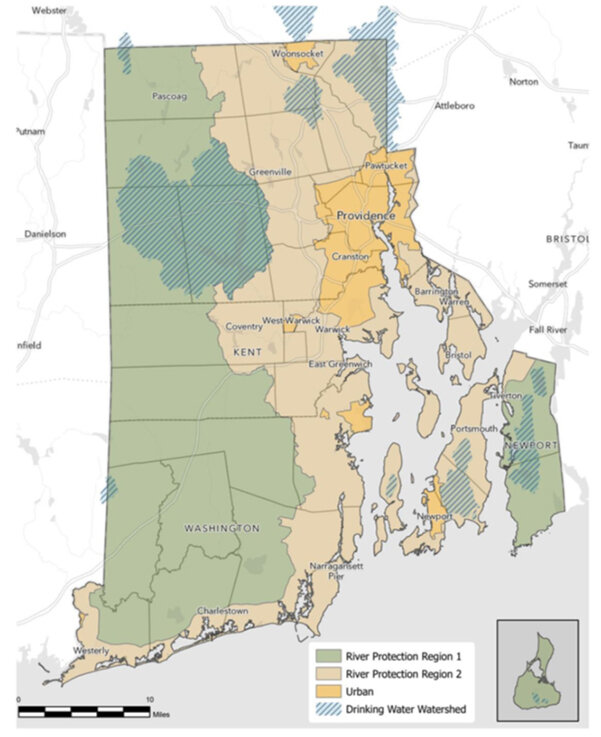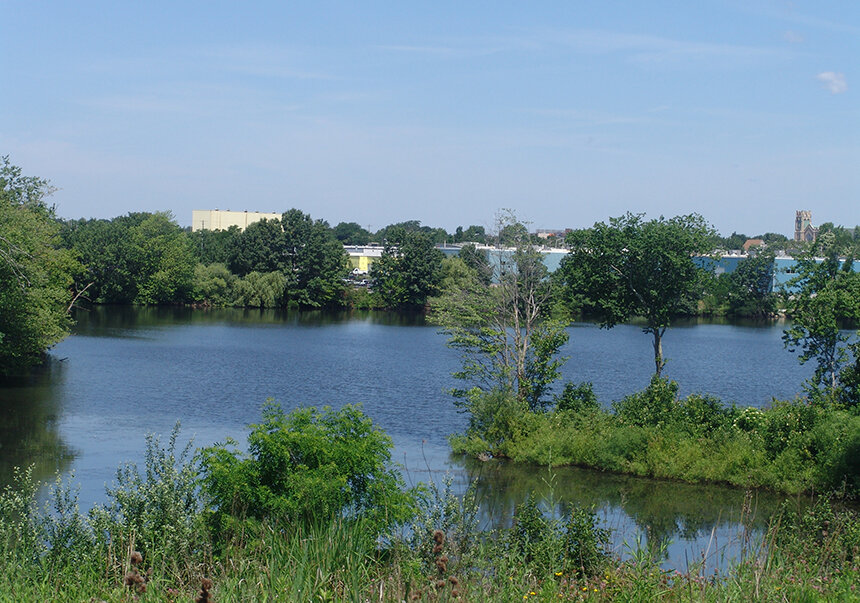New Freshwater Wetlands Rules Create Uniform Buffers
By ROB SMITH/ecoRI News staff
Stakeholders still have mixed reactions to new rules regarding Rhode Island’s freshwater wetlands. This summer the Rhode Island Department of Environmental Management (DEM) and the Coastal Resources Management Council (CRMC) filed rules mandating new protections for freshwater wetlands, in particular buffer zones — areas untouched by development — be kept a certain size adjacent to wetlands.
The new
regulations are scheduled to go into effect Jan. 15.
The new rules create different jurisdictional areas to be regulated by DEM and CRMC. They replace local ordinances in favor of statewide standards, a longstanding request by developers. In most cases, buffer areas will extend 200 feet from the edge of a river, floodplain or reservoir, and 100 feet for most other freshwater wetlands. DEM estimates 23,900 acres will fall under these new regulations.
Freshwater wetlands in Rhode Island include marshes, swamps, bogs, ponds, lakes, rivers, streams, vernal pools, and certain adjacent areas including floodplains. Any in the vicinity of the coast fall under CRMC jurisdiction, and all others are regulated by DEM. Wetlands reduce flood and storm damage, maintain stream flow during drought, protect and improve groundwater quality, provide habitat for fish and other wildlife.
Critics say that areas that will now have lower buffer limits — because some municipal regulations required more protection — will endanger important environmental benefits wetlands provide.
Save The Bay riverkeeper Kate McPherson doesn’t support the new statewide buffer zones.
“Urban wetlands and urban rivers pay the price for some gains in buffer protection elsewhere in the state, and Save The Bay is really disappointed in this outcome,” she said.
McPherson noted her concern is the buffers as they are to be enacted are too small and will further impact water quality and habitats. Water quality can be impacted if a residential development uses fertilizer, or if an invasive species escapes from a backyard.
“Wetlands are an important wildlife habitat, food source, shade rivers and streams, and help protect fish habitats,” she said.
Most municipalities will see an increase in buffer protection areas. A few, such as Jamestown and Little Compton, will see a decrease in their current buffer zones, from 150 feet to just 50. Municipalities can petition DEM for an increase in buffer areas, but are losing veto power originally granted to them in a previous version of the proposed rules.
The new rules create different jurisdictional areas to be regulated by DEM and CRMC. They replace local ordinances in favor of statewide standards, a longstanding request by developers. In most cases, buffer areas will extend 200 feet from the edge of a river, floodplain or reservoir, and 100 feet for most other freshwater wetlands. DEM estimates 23,900 acres will fall under these new regulations.
Freshwater wetlands in Rhode Island include marshes, swamps, bogs, ponds, lakes, rivers, streams, vernal pools, and certain adjacent areas including floodplains. Any in the vicinity of the coast fall under CRMC jurisdiction, and all others are regulated by DEM. Wetlands reduce flood and storm damage, maintain stream flow during drought, protect and improve groundwater quality, provide habitat for fish and other wildlife.
Critics say that areas that will now have lower buffer limits — because some municipal regulations required more protection — will endanger important environmental benefits wetlands provide.
Save The Bay riverkeeper Kate McPherson doesn’t support the new statewide buffer zones.
“Urban wetlands and urban rivers pay the price for some gains in buffer protection elsewhere in the state, and Save The Bay is really disappointed in this outcome,” she said.
McPherson noted her concern is the buffers as they are to be enacted are too small and will further impact water quality and habitats. Water quality can be impacted if a residential development uses fertilizer, or if an invasive species escapes from a backyard.
“Wetlands are an important wildlife habitat, food source, shade rivers and streams, and help protect fish habitats,” she said.
Most municipalities will see an increase in buffer protection areas. A few, such as Jamestown and Little Compton, will see a decrease in their current buffer zones, from 150 feet to just 50. Municipalities can petition DEM for an increase in buffer areas, but are losing veto power originally granted to them in a previous version of the proposed rules.
 |
| The freshwater wetlands buffer regions map. The new rules replace local zoning regulations with statewide standards. (DEM) |
Any development in these newly defined buffer areas will require a special permit, unless otherwise exempt. DEM has made additions to possible exemptions.
New exempt activities to freshwater wetlands rules now include cutting vegetation within lawns or landscape areas, forest management practices, cutting within floodplains outside wetlands and jurisdictional areas, maintenance of parking lots, additions of gates or barriers at existing and approved driveways and access roads, installation of signage, restoring wetlands from unauthorized disturbances associated with enforcement action, and establishing new pedestrian trails outside of wetlands and their buffer zones.
These exemptions, according to DEM, are “limited activities that do not present impacts to freshwater wetlands that merit review.” The rules also establish a process for a general permit, for routine projects with predictable and limited impacts.
Not all environmental organizations have been critical of the new rules. Save The Lakes, an organization dedicated to the preservation and protection of Rhode Island’s freshwater resources, believes DEM handled public comment reasonably well. In an email to ecoRI News, Save The Lakes director Ron Entringer wrote, “I think the final rule meets our expressed comments.”
Some in the business community, however, are displeased with the new buffer regulations, claiming they will impair the ability to build affordable housing. The Rhode Island Builders Association submitted 72 pages of testimony to DEM in January laying out its concerns. The association said the new rules would impact development in the western part of the state and would hinder homeowners from doing projects on their own property. It claimed DEM’s cost-benefit analysis was fundamentally unsound. The buffer sizes are also much bigger than other states in New England, according to the Rhode Island Builders Association.
Rhode Island Association of REALTORS president Philip Tedesco said of the new regulations, “We are satisfied that the new rules for wetland buffers are a step in the right direction ecologically without being overly onerous in terms of increased zoning regulations that raise the cost of housing.”
Efforts to create statewide wetlands protection standards began in 2013 with a 16-member legislative task force. Based on its recommendations, the General Assembly passed a legislative mandate in 2015 that called on DEM and CRMC to establish freshwater wetlands protections and enforce them. The process was delayed because of disagreements between environmental and business interests, DEM staff retirements, the coronavirus pandemic, and a state mandate to digitize all rules online.
“We believe the proposed regulations provide a balance between the benefits of environmental protection, the economic interests of land development, and the need for more affordable housing in our state,” said acting DEM director Terrance Gray. “The regulations provide certainty and consistency on the standards for wetlands permitting across the state and more options for quicker, streamlined permitting for development and affordable housing projects, while ensuring better buffers for important wetlands areas to protect their functions and values.”
New exempt activities to freshwater wetlands rules now include cutting vegetation within lawns or landscape areas, forest management practices, cutting within floodplains outside wetlands and jurisdictional areas, maintenance of parking lots, additions of gates or barriers at existing and approved driveways and access roads, installation of signage, restoring wetlands from unauthorized disturbances associated with enforcement action, and establishing new pedestrian trails outside of wetlands and their buffer zones.
These exemptions, according to DEM, are “limited activities that do not present impacts to freshwater wetlands that merit review.” The rules also establish a process for a general permit, for routine projects with predictable and limited impacts.
Not all environmental organizations have been critical of the new rules. Save The Lakes, an organization dedicated to the preservation and protection of Rhode Island’s freshwater resources, believes DEM handled public comment reasonably well. In an email to ecoRI News, Save The Lakes director Ron Entringer wrote, “I think the final rule meets our expressed comments.”
Some in the business community, however, are displeased with the new buffer regulations, claiming they will impair the ability to build affordable housing. The Rhode Island Builders Association submitted 72 pages of testimony to DEM in January laying out its concerns. The association said the new rules would impact development in the western part of the state and would hinder homeowners from doing projects on their own property. It claimed DEM’s cost-benefit analysis was fundamentally unsound. The buffer sizes are also much bigger than other states in New England, according to the Rhode Island Builders Association.
Rhode Island Association of REALTORS president Philip Tedesco said of the new regulations, “We are satisfied that the new rules for wetland buffers are a step in the right direction ecologically without being overly onerous in terms of increased zoning regulations that raise the cost of housing.”
Efforts to create statewide wetlands protection standards began in 2013 with a 16-member legislative task force. Based on its recommendations, the General Assembly passed a legislative mandate in 2015 that called on DEM and CRMC to establish freshwater wetlands protections and enforce them. The process was delayed because of disagreements between environmental and business interests, DEM staff retirements, the coronavirus pandemic, and a state mandate to digitize all rules online.
“We believe the proposed regulations provide a balance between the benefits of environmental protection, the economic interests of land development, and the need for more affordable housing in our state,” said acting DEM director Terrance Gray. “The regulations provide certainty and consistency on the standards for wetlands permitting across the state and more options for quicker, streamlined permitting for development and affordable housing projects, while ensuring better buffers for important wetlands areas to protect their functions and values.”
